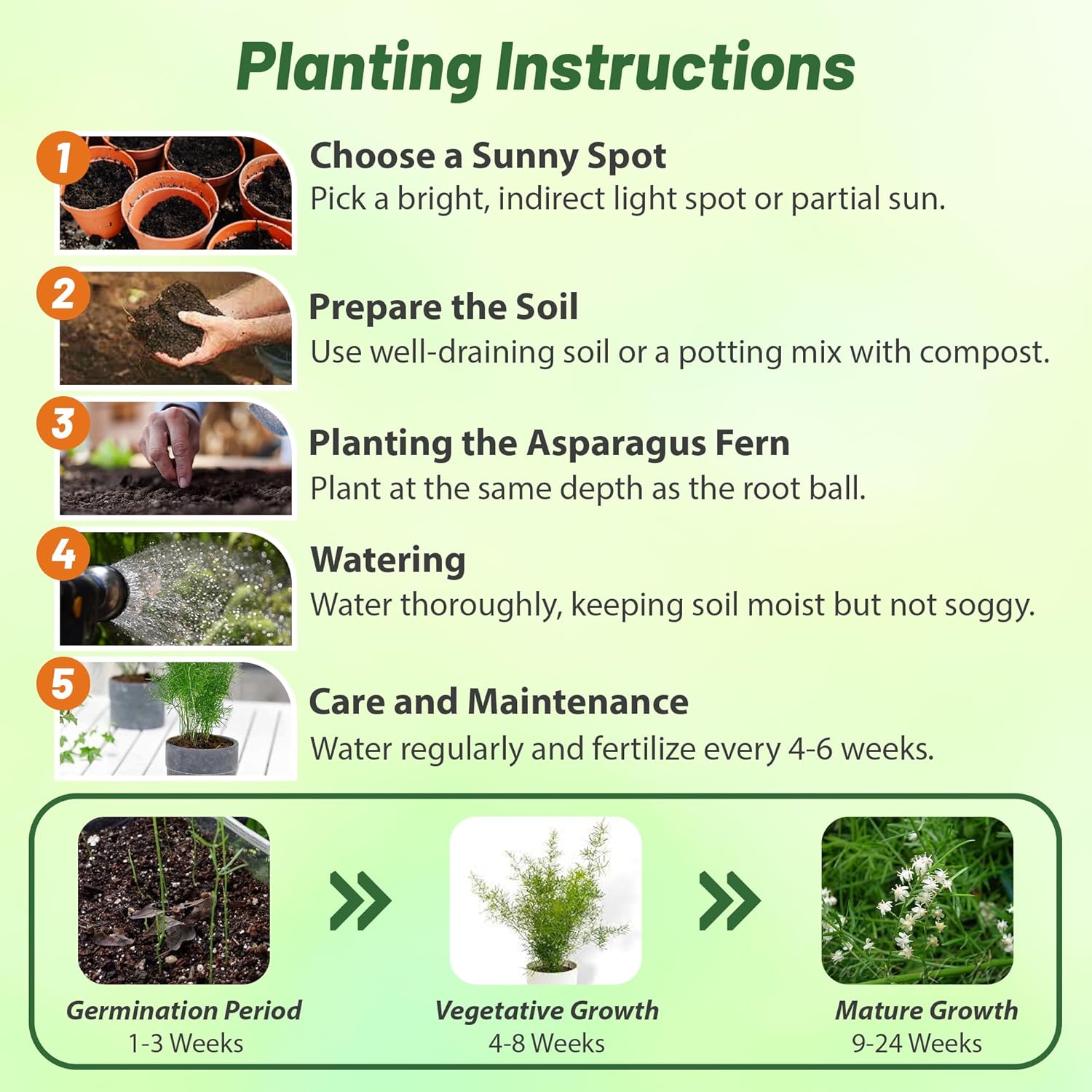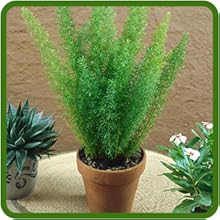-
CATEGORY ::
- All Seeds /
- All Flower Seeds /
- All Asparagus Fern Seeds









Asparagus Fern Seeds - Sprengeri
About...
Asparagus Fern (Asparagus Densiflorus Sprengeri) - The Asparagus Fern features trailing bright glossy foliage. When planted in containers, the unique feathery foliage makes a lovely complement to flowers. It makes an excellent house plant and works well in hanging baskets.
MORE ASPARAGUS FERN OPTIONS
Planting Directions
TEMPERATURE
75F
AVERAGE GERM TIME
21 - 35 days
LIGHT REQUIRED
Yes
DEPTH
Do not cover
SOWING RATE
3 - 4 seeds per plant
MOISTURE
Keep moist until germination
PLANT SPACING
36 inches









Asparagus Fern (Asparagus Densiflorus Sprengeri) - Asparagus Sprengeri seeds are the way to start this popular foliage plant! The Asparagus Fern features trailing bright glossy foliage. When planted in containers, the unique feathery foliage makes a lovely complement to flowers. It makes an excellent house plant and works well in hanging baskets. Asparagus Fern is a slightly woody evergreen plant with upright or trailing branches. It is easily established from flower seed, and it is easy to grow and drought-tolerant. This fern-like perennial develops into a fast-growing, sprawling ground cover, or a nice-sized houseplant that requires minimal care. Grows 24 inches in height and 24 - 36 inches wide in full to part sun. Grown in some shade, the foliage will maintain a deeper green color. It likes moist but well-drained soil.
Asparagus Fern produces a flower. The flowering time lasts for roughly two weeks during the summer. Bright red berries follow the inconspicuous, fragrant white or pale pink flowers. Birds are highly attracted to the fruit and aid in the dispersal of the flower seed. Sow Asparagus Fern seeds in potting mix indoors. Transplant outdoors after danger of frost.
Common Questions
How long does an asparagus fern live?
Regular repotting and care can extend the lifespan of an asparagus fern as a houseplant indefinitely, while neglect may lead to its demise due to becoming root-bound. Outdoor plants have more space to spread and thrive.
What's the difference between asparagus fern, and the asparagus we eat as a vegetable?
Asparagus ferns and edible garden asparagus belong to distinct species under the same Asparagus genus. The garden asparagus, identified as A. officinalis, is a perennial vegetable that grows slowly. While it may resemble the asparagus fern species, this type of asparagus produces tasty edible stems that are typically harvested before the plant fully leafs out in the spring.
Why are my asparagus fern dropping their foliage?
This issue typically arises due to irregular watering. These plants thrive when not overly saturated with water, but they also dislike being completely dry. Finding the correct watering schedule can be challenging, particularly in colder regions where indoor air tends to be very dry in winter. The key solution for a plant experiencing excessive shedding is usually more frequent watering and misting.
Do I need to prune my asparagus fern?
The asparagus fern grows rapidly, so consider trimming it to maintain a neat appearance. Alternatively, you can let it grow freely for a more untamed look. To trim, use sharp scissors or clean garden shears to eliminate any brown areas or rejuvenate an older plant. Remember to cut at the base rather than in the middle of a stem.
Planting Directions
TEMPERATURE
75F
AVERAGE GERM TIME
21 - 35 days
LIGHT REQUIRED
Yes
DEPTH
Do not cover
SOWING RATE
3 - 4 seeds per plant
MOISTURE
Keep moist until germination
PLANT SPACING
36 inches









Asparagus Fern (Asparagus Densiflorus Meyeri) - Starting Foxtail Fern seeds is an easy way to add many of these unique plants to your landscape! Asparagus Meyeri is an evergreen arching perennial that has feathery, needle-like, stems and is grown from flower seeds.
Common Questions
Should I keep my asparagus Foxtail fern in direct sunlight?
This depends. In the winter months your plant will do well in direct sunlight, but in the summer months it should only be given dappled sunlight.
Do I need to prune my foxtail fern?
Yes, plants require regular pruning, occasional misting, and rotation of the pot for even sun disbursement.
Do I need to fertilize my foxtail fern plants?
Yes, you will need to fertilize your foxtail once monthly, or more often if the leaves start to turn a pale yellow color.
What is the best way to water my plants?
Do not allow the soil to completely dry out. If the soil is too dry leaves will begin to shed. Water with room temperature water. If you live in a dry climate, be sure to keep your house plant on top of wet pebbles to encourage proper moisture balance.
How often do you water foxtail ferns?
Watering the foxtail fern should occur when the top three inches of soil are dry to the touch. To prevent root rot, it is crucial to refrain from overwatering. The plant thrives on regular moisture with intervals of slight dryness between watering. In winter, watering frequency should be decreased while ensuring the soil remains slightly moist.
Where do foxtail ferns grow best?
This means they prefer dappled sunlight, warm temperatures, and high humidity. They can be grown indoors in pots or outdoors if the climate conditions are suitable.
































